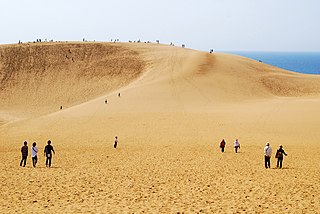Graphs are unavailable due to technical issues. There is more info on Phabricator and on MediaWiki.org. |
The following is a list of dams in Tottori Prefecture, Japan.
Graphs are unavailable due to technical issues. There is more info on Phabricator and on MediaWiki.org. |
The following is a list of dams in Tottori Prefecture, Japan.

Tottori Prefecture is a prefecture of Japan located in the Chūgoku region of Honshu. Tottori Prefecture is the least populous prefecture of Japan at 538,525 (2023) and has a geographic area of 3,507.13 square kilometres (1,354.11 sq mi). Tottori Prefecture borders Shimane Prefecture to the west, Hiroshima Prefecture to the southwest, Okayama Prefecture to the south, and Hyōgo Prefecture to the east.

Chizu is a town located in Yazu District, Tottori Prefecture, Japan. As of 1 January 2024, the town had an estimated population of 5,906 in 2681 households and a population density of 26.3 persons per km². The total area of the town is 224.70 square kilometres (86.76 sq mi).

Nichinan is a town located in Hino District, Tottori Prefecture, Japan. As of 31 December 2021, the town had an estimated population of 4,144 in 1903 households and a population density of 12 persons per km2. The total area of the town is 340.962 square kilometres (131.646 sq mi), representing 10% of the total area of Tottori Prefecture.Over 90% of the town is covered by mountains and forest, and 5% of the land is arable. Areas of Nichinan are part of Hiba-Dogo-Taishaku Quasi-National Park.

Tottori is the capital and the largest city of Tottori Prefecture in the Chūgoku region of Japan. As of 30 November 2022, the city had an estimated population of 183,383 in 81,732 households and a population density of 240 persons per km². The total area of the city is 765.31 square kilometres (295.49 sq mi). Most of the city is within the San'in Kaigan Geopark.

The Hino River is a major river in the western part of Tottori Prefecture. The river flows east-northeast for 77 kilometres (48 mi), and is the longest river in the prefecture. The Hino River emerges from the Chūgoku Mountains. The source of the river is at an elevation of 1,004 metres (3,294 ft) in an area near Mount Mikuni and Mount Dōgo in Nichinan in southeastern Tottori Prefecture. At Kofu, the river turns north-northwest. The lower part of the Hino River flows through the Yonago Plain before finally discharging into Miho Bay at Hiezu near Yonago. Erosion over time has created the scenic Sekkakei Ravine. The Sukesawa Dam forms an artificial lake, Lake Nichinan. Approximately 60,800 people use the water provided by the Hino River.

National Route 29 is a national highway connecting Himeji and Tottori in Japan.

The Sendai River is a river in eastern Tottori Prefecture, Japan. The Sendai is 52 kilometers (32 mi) in length and has a drainage area of 1,190 square kilometers (460 sq mi). The source of the river is in the Chūgoku Mountains. The Sendai flows north through Tottori Prefecture into the Sea of Japan. Under the Rivers Act of 1964 it is designated a Class 1 River, and is managed by the Japanese Ministry of Land, Infrastructure, Transport and Tourism. About 200,000 people live along the course of the river. The Sendai River provides sediment to form the Tottori Sand Dunes, the largest dune system in Japan.